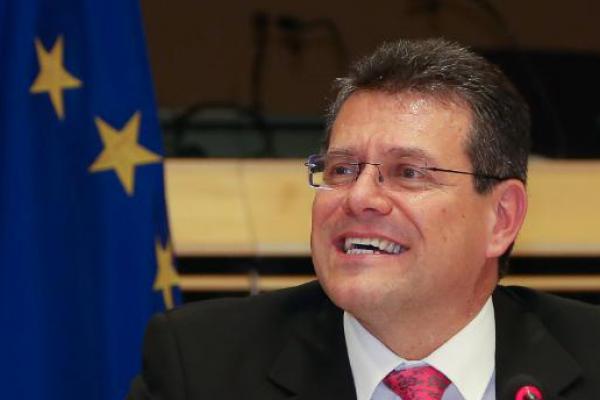The Energy Union aims to provide Europe with clean, secure and affordable energy that will help the EU become a carbon-neutral society in the second half of this century. To what extent is the challenge in the area of research and innovation rather than just policy?The IssueTheEnergy Unionaims to create a low-carbon economy which puts Europe at the forefront of renewable energy.There are five dimensions to the strategy. Research, innovation and competitiveness is one, along with security, solidarity and trust between Member States, a fully integrated internal energy market, energy efficiency and climate action.As part of its Energy Strategy, the EU has set out three targets for 2030: to cut greenhouse gas emissions by 40 % compared to 1990 levels, to achieve at least a 27 % share of renewable energy consumption and to generate at least 27 % energy savings compared with the business-as-usual scenario.‘We have a lot of challenges ahead of us: how to make sure the historic Paris Agreement (from the COP21 climate talks) is properly implemented, how to restore price signals in our electricity market design, what kind of legal framework we need for new promising technologies, from eMobility all the way down to drones. Then, of course, how to make sure our energy and climate policies are in sync.‘Research and innovation is an extremely important part. I have been working closely with Commissioner Carlos Moedas in this area. We can have the best policies and the most modern regulative framework, but to achieve our 2030 goals, and a carbon-neutral society by the second half of this century, we need research and innovation to develop breakthrough technologies that can be used by citizens and companies.’How will the Energy Union support these breakthrough technologies?‘Before the end of the year we will have the Renewables, Energy Efficiency and Market Design Package. These legislative initiatives will provide a clear and stable forward-looking framework which makes clear that innovative solutions are needed to support the energy transition to a low-carbon society. The accompanying ‘Accelerating Clean Energy Innovation’ Communication sets out the policy levers we have at EU level to attract the private investments we need to match our public investments and where we will focus our activities.‘First, it’s quite clear that what we need to focus on is storage. Most renewables by nature are intermittent, like wind and solar, and we need to store that energy. We are looking at different technologies at different sizes. When I talk to the wind industry they want solid battery storage at the base of the turbine. When we talk to smart grid operators they would like to have an industrial type of energy storage, and then it will also be important to develop storage for households. I believe batteries in the cars and buses could even serve as a storage for renewable energy sources, if not on the district, at least on the city level. Then, of course, we will continue with the further penetration of renewables.’The 2030 energy efficiency targets were criticised for not being ambitious enough. How can the Energy Union help maintain progress and drive the uptake of energy efficiency technologies?‘We can be very proud of what Europe has accomplished; no other major economy has reduced greenhouse gases by 24 % and grown by 46 %, from 1990 levels. We now have to really do our utmost to benefit from the expertise and technological advancements we have made so far.‘A big part of the upcoming package will be devoted to energy efficiency from the regulatory point of view, to target setting, governance and also financing. It’s quite clear that we have an opportunity goldmine because of the building stock in Europe which is still very energy intensive. Over 40 % of the energy we consume is for heating and cooling buildings.“‘A big part of the upcoming package will be devoted to energy efficiency from the regulatory point of view, to target setting, governance and also financing.’Maroš Šefčovič, Vice-President of the European Commission in charge of Energy Union‘After December, we will make sure that Member States seize the advantage that was already built in Europe. We will talk to them about how they want to contribute to advancing the Energy Union, how they see themselves in this new transitional period and how they see themselves fitting in to regional cooperation.‘We also want to help the mayors, the entrepreneurs, the active citizens who want to consume less energy and live in a clean environment, with a new initiative called Smart Finance for Smart Buildings. We are looking at how we can link it up with the EFSI (European Fund for Strategic Investments) and start an energy efficiency wave throughout Europe, and create the demand that would also boost researchers and innovators to introduce these new energy-efficient technologies.‘When I was in the Netherlands and Germany I was astonished to see what our researchers are doing; some have developed plastics to cover buildings and generate energy. At this stage I can imagine they are probably too expensive to scale up. There are a lot of other technologies that need a boost to create demand and we hope to do that in December.’At theTransition to a Green Economyconference in Bratislava, Slovakia, in September, you mentioned that the energy transition would be a goldmine for jobs and growth, but some people would lose out. How can we make sure workers won’t lose jobs?‘People are behind everything we do and it’s quite clear that traditional industries or the carbon-intensive regions face a challenge. Here the national and European decision makers should not only be aware of this challenge, but they should be ready to help. We have several examples of how this can be done, like EnergyVille in Genk (Belgium) where you can still see the old towers of the coal mines but at the same time you also see a state-of-the-art modern research and innovation centre (focusing on sustainable and intelligent energy) on the same premises. They once mined black gold and now they are working on green gold. There are even more employees now than during the peak of coal mining in that region.’What can be done to make sure more industries join the energy transition?‘What I hear from a lot from market operators is that they know about technologies, ideas and even the financing, but they don’t have the people with the adequate skills. Everyone knows we need more IT people, but we also need a lot more experts on energy efficiency, renewables, smart grids and construction workers who understand and are able to install all these new technological devices.‘But from what I have seen in our labs with all this new promising technology we are supporting, and will continue to support thanks to Horizon 2020, I wouldn’t exclude a similar revolution (to that which) we have seen in mobile telephones and the huge speed of hyper-connectivity. I would guess the energy transition could evolve in the same way.’
This article was originally published in Horizon, the EU Research and Innovation magazine.
Add to favorites:
Share:
Listing Description
Video
Documents
No documents available.
Ask KETMarket to make a contact
Connect with the Listing Owner!
💬 Please log in now to askKETMarket to make a contact. Not a member yet? Sign up for free and start connecting today!
Video
Related Funding and Finance Opportunities
Unlock Exclusive Funding Opportunities!
🔑 Get instant access to tailored funding opportunities that perfectly match your needs. This powerful feature is exclusively available to our premium members—helping you save time, stay ahead of the competition, and secure the right funding faster.
Upgrade to Premium now and never miss an important opportunity again! Already a premium member? Log in here to explore your matches.
Related Innovation Offers
Discover Tailored Innovation Offers!
🚀 Gain access to technology solutions that match your specific needs and interests—carefully selected to support your innovation goals. These offers are exclusively available to our premium members, helping you identify relevant technologies faster and start the right conversations with potential partners.
Upgrade to Premium now and explore your personalized technology matches today! Already a premium member? Log in here to view your tailored offers.
Related Knowledgeable Resources
Discover More with Premium: Related Knowledge Resources
🔒 You’re missing out on expert-curated knowledge specifically matched to this topic. As a Premium member, you gain exclusive access to in-depth articles, guides, and insights that help you make smarter decisions, faster.
Whether you’re preparing a funding proposal, researching a new market, or just need reliable information—our Premium knowledge matches save you hours of research and point you directly to what matters.
Upgrade to Premium now and instantly unlock relevant knowledge tailored to your needs! Already a member? Log in here to view your personalized content.

